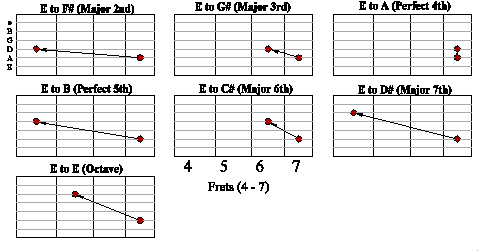Intervals
|
The E Major Scale
|
Major 2nd -
Major 2nd - Minor 2nd -
Major 2nd - Major 2nd -
Major 2nd - Minor
2nd
Another way to show intervals in the major scale is to show
them in relation to the root note.
For example: E to B or E to C# or E to F#
...
Let's look at this.
| Notes | Interval |
| E to F# | Major 2nd |
| E to G# | Major 3rd |
| E to A | Perfect 4th |
| E to B | Perfect 5th |
| E to C# | Major 6th |
| E to D# | Major 7th |
| E to E | Octave |
Now let's see how this relates to the E major
scale (1 Octave).
 Now here's the tab for the diagram above
Now here's the tab for the diagram above
|
Maj 2nd Maj 3rd Per 4th Per 5th Maj 6th Maj 7th Octave E
|-------|-------|-------|-------|-------|-------|-------| B
|-------|-------|-------|-------|-------|-----4-|-----5-| G
|-------|-------|-------|-----4-|-----6-|-------|-------| D
|-----4-|-----6-|-----7-|-------|-------|-------|-------| A
|--7----|--7----|--7----|--7----|--7----|--7----|--7----| E
|-------|-------|-------|-------|-------|-------|-------| |
When you do this you are not just restricted to using the major scale. You can also use the modes (shown in Modes). All you have to do is take the interval chart (like in figure 3) that I gave with each mode, then you proceed from there.